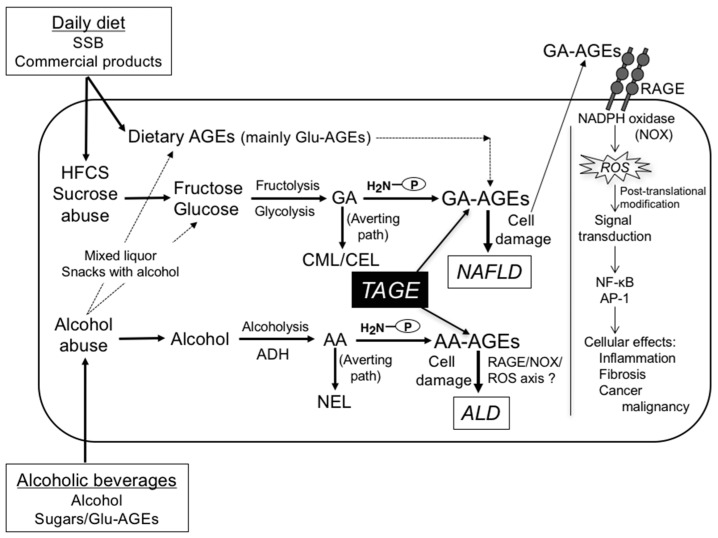Figure 3.
The toxic AGE (TAGE) theory for the pathophysiology of NAFLD and ALD: The chronic ingestion of an excessive daily diet (SSB and commercial products, which contain HFCS/sucrose) increases the levels of the sugar metabolite, glyceraldehyde (GA), while the chronic consumption of an excessive number of alcoholic beverages increases the levels of the alcohol metabolite, acetaldehyde (AA) in the liver. GA or AA is known to react non-enzymatically with the ε- or α-amino groups of proteins to form reversible Schiff bases and then Amadori products. These early glycation products undergo further complex reactions such as rearrangement, dehydration, and condensation to become irreversibly cross-linked, heterogeneous fluorescent derivatives termed “AGEs” (GA-AGEs or AA-AGEs). The CML/CEL or NEL pathway for the reaction of Amadori products may be a physiologically relevant mechanism for averting the generation of GA-AGEs or AA-AGEs (the predominant components of TAGE), and, thus, prevent potential cellular toxicity arising from the generation of TAGE in vivo. Furthermore, the chronic ingestion of excessive dietary AGEs (mainly Glu-AGEs) further promotes the enhanced generation/accumulation of GA-AGEs and expression of RAGE. As a result, GA-AGEs accumulate in cells, cause cell damage, and leak into the blood, and, thus, GA-AGE levels in circulating fluids may be considered to increase. Extracellular GA-AGEs induce inflammation, fibrosis, and cancer malignancy via RAGE-NOX-ROS signaling. The GA-AGE-RAGE axis may lead to ROS generation by NOX. Oxidative hepatic injury may result from the direct attack of ROS on essential biomolecules, including lipids, proteins, and DNA, with the subsequent activation of cell death pathways and loss of biological functions and hepatocyte viability. ROS may indirectly activate redox sensitive transcription factors, including NF-κB and activator protein-1 (AP-1), which trigger the production of cytotoxic, pro-inflammatory, and fibrogenic mediators by HSCs, thereby promoting NAFLD disease progression. AA-AGEs may also bind to RAGE and generate ROS, which trigger signal transduction in hepatocytes/HSCs. However, the exact molecular mechanisms underlying the generation of ROS by AA-AGEs remain unclear. Alcoholic beverages (particularly mixed liquor) contain large amounts of sugars and Glu-AGEs may generate/accumulate TAGE (AA-AGEs and GA-AGEs). Taken together, our theory suggests that TAGE are novel therapeutic targets for preventing lifestyle-related diseases. Therefore, inhibiting the generation/accumulation of TAGE is a promising target for the novel prevention of and therapeutic interventions for NAFLD and ALD. SSB: sugar-sweetened beverages; HFCS: high-fructose corn syrup; ADH: alcohol dehydrogenase; GA: glyceraldehyde; GA-AGEs, GA-derived AGEs; AA: acetaldehyde; AA-AGEs, AA-derived AGEs; CML, N-(carboxymethyl)lysine; CEL, N-(carboxyethyl)lysine; NEL, N-(ethyl)lysine; NAFLD, non-alcoholic fatty liver disease; ALD, alcoholic liver disease; TAGE, toxic AGEs; RAGE: receptor for AGEs; ROS: reactive oxygen species; P-NH2, free amino residues of proteins.

